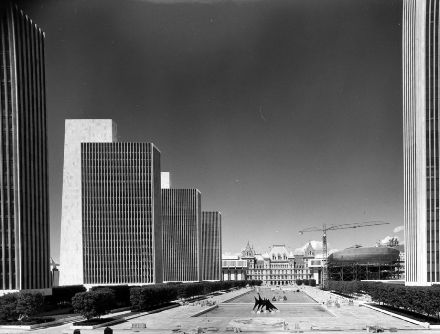Travel Picks: 10 top ugly buildings and monuments
SYDNEY (Reuters Life!) ? Travel can open your eyes to some of the world's most beautiful sights and buildings -- and to some of the ugliest.
Web site VirtualTourist.com (www.virtualtourist.com) has come up with a list of "The World's Top 10 Ugliest Buildings and Monuments" according to their editors and readers. Reuters has not endorsed this list.
"Some of these picks have all the charm of a bag of nails while others are just jaw-dropping in their complexity. Love them or hate them, the list is certainly entertaining," said General manager Giampiero Ambrosi.
1. Boston City Hall; Boston, Massachusetts
While it was hip for it's time, this concrete structure now gets routinely criticized for its dreary facade and incongruity with the rest of the city's more genteel architecture. Luckily, it's very close to more aesthetically pleasing attractions.
2. Montparnasse Tower; Paris, France
While it's almost universally agreed that this ominous stick is a blight on the landscape of the world's most stunning city, its detractors admit that there is one very good reason to take in the view from the building's observation deck: it's the only place you can go to get a view of the city without it.
3. LuckyShoe Monument; Tuuri, Finland
It may be over-the-top, but there is something to be said for the giant, golden horseshoe that looms over Finland's second-largest shopping center. The shoe, and, in fact, the entire town in which it is situated, is said to bring good luck.
4. Metropolitan Cathedral; Liverpool, England
The people who work here must be sick of the space capsule jokes. Even those who find the building's shell a bit "spacey," have to admit the circular interior is pretty spectacular.
5. Port Authority Bus Terminal; New York City, New York
Those who pass by this iron monstrosity might be tempted to ask about a completion date, but alas, this is the finished product.
6. Torres de Colon; Madrid, Spain
Like a set of giant salt-and-pepper shakers, these matching towers loom over the city to the dissatisfaction of many area residents. The buildings are also known as "El Enchufe" or "The Plug" for the plug-like structure that holds them together.
7. Liechtenstein Museum of Fine Arts; Vaduz, Liechtenstein
Some feel the building's minimalist box design is a triumph, others say it's an eyesore.
8. Scottish Parliament Building; Edinburgh, Scotland
Stone, oak, and bamboo are part of the make-up of the Scottish Parliament, a building that is the subject of much debate.
9. Birmingham Central Library; Birmingham, England
One look and it's easy to see how this genre of architecture came to be known as the "Brutalist" style. Not surprisingly, the issue of its possible demolition has been looming for years.
10. Peter the Great Statue; Moscow, Russia
Some 15 stories high, the larger-than-life monument was designed by controversial artist, Zurab K. Tsereteli, whose statue of Christopher Columbus was repeatedly rejected by the United States.
(Editing by Belinda Goldsmith)
http://news.yahoo.com/s/nm/20081114/lf_nm_life/us_travel_picks_ugly
SYDNEY (Reuters Life!) ? Travel can open your eyes to some of the world's most beautiful sights and buildings -- and to some of the ugliest.
Web site VirtualTourist.com (www.virtualtourist.com) has come up with a list of "The World's Top 10 Ugliest Buildings and Monuments" according to their editors and readers. Reuters has not endorsed this list.
"Some of these picks have all the charm of a bag of nails while others are just jaw-dropping in their complexity. Love them or hate them, the list is certainly entertaining," said General manager Giampiero Ambrosi.
1. Boston City Hall; Boston, Massachusetts
While it was hip for it's time, this concrete structure now gets routinely criticized for its dreary facade and incongruity with the rest of the city's more genteel architecture. Luckily, it's very close to more aesthetically pleasing attractions.
2. Montparnasse Tower; Paris, France
While it's almost universally agreed that this ominous stick is a blight on the landscape of the world's most stunning city, its detractors admit that there is one very good reason to take in the view from the building's observation deck: it's the only place you can go to get a view of the city without it.
3. LuckyShoe Monument; Tuuri, Finland
It may be over-the-top, but there is something to be said for the giant, golden horseshoe that looms over Finland's second-largest shopping center. The shoe, and, in fact, the entire town in which it is situated, is said to bring good luck.
4. Metropolitan Cathedral; Liverpool, England
The people who work here must be sick of the space capsule jokes. Even those who find the building's shell a bit "spacey," have to admit the circular interior is pretty spectacular.
5. Port Authority Bus Terminal; New York City, New York
Those who pass by this iron monstrosity might be tempted to ask about a completion date, but alas, this is the finished product.
6. Torres de Colon; Madrid, Spain
Like a set of giant salt-and-pepper shakers, these matching towers loom over the city to the dissatisfaction of many area residents. The buildings are also known as "El Enchufe" or "The Plug" for the plug-like structure that holds them together.
7. Liechtenstein Museum of Fine Arts; Vaduz, Liechtenstein
Some feel the building's minimalist box design is a triumph, others say it's an eyesore.
8. Scottish Parliament Building; Edinburgh, Scotland
Stone, oak, and bamboo are part of the make-up of the Scottish Parliament, a building that is the subject of much debate.
9. Birmingham Central Library; Birmingham, England
One look and it's easy to see how this genre of architecture came to be known as the "Brutalist" style. Not surprisingly, the issue of its possible demolition has been looming for years.
10. Peter the Great Statue; Moscow, Russia
Some 15 stories high, the larger-than-life monument was designed by controversial artist, Zurab K. Tsereteli, whose statue of Christopher Columbus was repeatedly rejected by the United States.
(Editing by Belinda Goldsmith)
http://news.yahoo.com/s/nm/20081114/lf_nm_life/us_travel_picks_ugly






